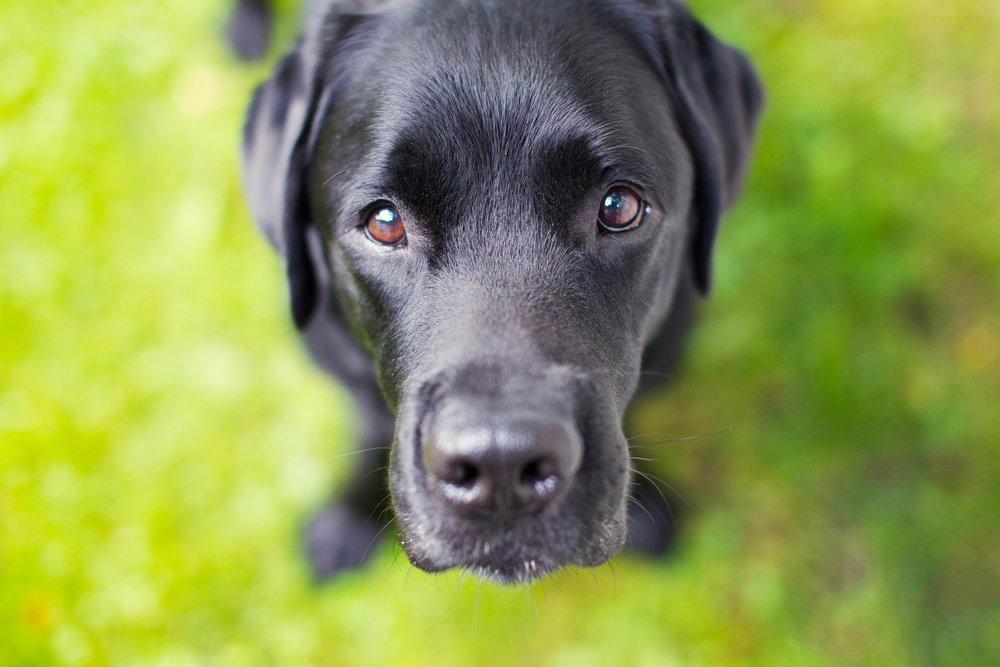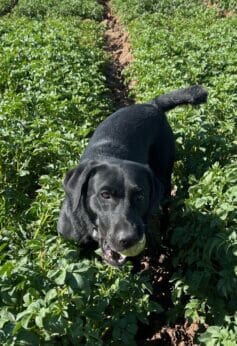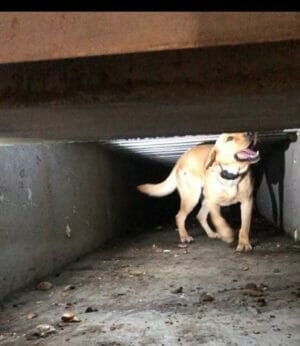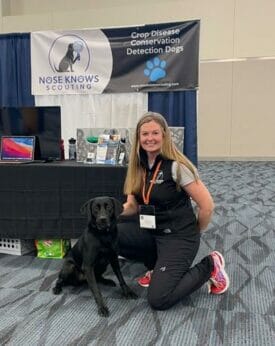Potato Virus? Call in the Dogs
Farmers and researchers are working to stem a devastating potato virus using what only a dog’s nose knows.
Potato Virus? Call in the Dogs
Farmers and researchers are working to stem a devastating potato virus using what only a dog’s nose knows.

by Shutterstock.
Andrea Parish holds back Zora, her black Labrador Retriever, who is coiled like a spring. Zora, a detection dog, can’t wait to get to those potatoes. Parish scans the environment for potential distractions—how noisy is it? Did the wind just change?—then releases Zora and watches her posture and ear and tail positions for cues. Zora goes from crate to crate, sniffing the tubers. Finally, Zora freezes, the final sign that tells Parish she has found the disease. Zora has earned her tennis ball and potentially saved a farmer thousands of dollars.
A dog’s nose is a wonder. While humans come equipped with about six million olfactory receptors, dogs have 300 million. As we use vision, they use scent. It’s hard to quantify, but estimates of how canine nose power compares to ours range from 10,000 times to a million times greater. As an example, dogs can discern substances as small as one part per trillion—that’s a single drop of liquid in 20 Olympic-sized swimming pools.
In addition to finding their pack, a mate or their next meal, dogs can detect heat, emotions, hormones and human diseases such as cancer, diabetes and COVID-19. But it’s not just human diseases that our canine companions can sniff out. The agriculture industry now knows dogs can also detect plant diseases such as Potato virus Y (PVY).
Spread by aphids, PVY plagues potato growers worldwide by reducing tuber yields and deforming potatoes. In Idaho, the country’s largest producer of potatoes, PVY is estimated to cost the state $34 million annually. The study calculated a loss in returns between $90 and $120 per acre with 10 percent PVY in the tubers.

The typical test involves scooping an eye out of a mature tuber to be tested, sacrificing a percentage of healthy tubers. Andrea Parish’s team of four specialist Labrador Retrievers can flush out PVY in storage before the growing season begins or in the field without harming the tubers. Her firm Nose Knows Scouting travels the country assessing fields and crops and also accepts mail-order samples.
In 2019, Parish was training dogs in search-and-rescue and married to a potato crop consultant. She began to wonder why dogs weren’t helping track down crop diseases. “We have really high levels of PVY right now,” she says, “and if there is too much in, say, a proprietary variety, they’ll stop production of that variety, and it is shut down.”
Parish maintains that a dog’s nose is simply better than any technology we have. “The military uses bomb dogs after they tried everything else,” she says. “Every country has tried to replace bomb dogs’ noses, and what are they using? Dogs.”
A dog and handler gets certified on a scent, whether a bomb or a virus, as a team, requiring intensive training. Parish prefers not to train other scents to keep her dogs “accurate and ethical” on PVY.

She says when potato plants are small, her dogs can test 120 acres in two hours.
To further her training, she partnered with a career military and law enforcement dog trainer who certifies dogs worldwide in bomb and drug detection. She’s done more than one 80-week training session with several dogs now, focusing on PVY.
“I treat PVY as if it’s as important as finding a bomb,” she says, because it’s that devastating to a farm.
When a detector dog finds the chosen substance, it “indicates” with a trained behavior, such as sitting or freezing and pointing. Dogs are usually rewarded with a toy such as a tennis ball.
“You can train a scent pretty quickly,” says Parish. “Quickly” is relative: She notes that it takes approximately 12,000 repetitions of having them sniff the target odor, but training environment, athletic performance and reliability take much longer.
“It’s finding the dog that’s hard,” says Parish. “Dogs are really smart—they’ll take shortcuts. That is why daily training and testing is so important.” The dogs need constant reinforcement to stay sharp and intense physical exercise, which Parish says reinforces their detection abilities. Beyond scent drills in varied locations, they are up at 5:30 a.m. for walks and hit the treadmill daily.
Parish’s dogs have been trained to run through the air ducts (plenums) below storage bins to sniff out diseased tubers and walk conveyor belts to check seeds. For each environment, handlers must understand and predict how air flow, air pressure and temperature can affect the dog. And, of course, each dog has its own personality.
You need a dog that will stay focused despite physical or environmental distractions. Parish says she looks for the “one-percenters”—the ones driven by “the pure joy of working under any conditions; they live by their nose.”

Borrowing the dog’s innate love for sniffing, called neophilia, Parish sees strong results. “I can now show up at any farm or university and they’ll give me a potato with PVY and the dog will hit it every time,” says Parish. “Everyone we have worked with has been very happy with us. We work with everyone from the breeding program to the processors.”
In one test, at North Dakota State University, Parish and Zora evaluated all of the NDSU potato breeding program’s germplasm, including 1,000 different genotypes, in less than a day.
“What we tested this morning with the dog would have taken us three months in the lab,” NDSU potato breeder Asunta (Susie) Thompson told NDSU’s agriculture department.
Testing like this could enable faster breeding, bringing new potato varieties to producers and the market sooner.
Parish is part of a two-year study with Montana State University’s seed certification program in winter and summer testing in which Zora is going “head to head” with current methods.
As part of the study, Nose Knows Scouting tested indoor tuber samples, and tubers flagged by Zora were then sent to Hawaii for testing for PVY. This summer, it is investigating a ¼-acre grow field with some known contaminated plants, and the dog’s results will be cross checked with visual inspections and lab test results.

Nina Zidack, director of the Seed Certification Program, has seen Parish and Zora in action with known contaminated samples.
“The dogs can absolutely smell PVY, there’s no doubt about it,” she said in a phone interview.
“The main thing we are looking at is how to use that as a tool; for instance, if a farmer could use that to rogue plants out of field or if they could use it to determine if a seed lot had PVY. Or, from a seed certification position, if we could ever use it as another test for PVY—I think that is less likely, but we are evaluating it.”
It seems humans are catching on to the myriad ways dogs’ unseen technology can help our society. Beyond potatoes, dogs are also helping detect disease in grapes, apples and citrus for the United States Department of Agriculture and in growing operations around the country often well before current methods—as well as pests such as Japanese beetles. In one USDA training exercise in Florida, dogs were 99 percent accurate on identifying citrus canker.
For industry-wide impact, Parish says she would like to see dogs used on a wider scale. “Having multiple handlers in multiple states, we could actually get rid of PVY. If we had enough handlers and dogs, we could sniff every potato out there.”
Follow us
This work is licensed under a Creative Commons Attribution-NoDerivatives 4.0 International License.
Want to republish a Modern Farmer story?
We are happy for Modern Farmer stories to be shared, and encourage you to republish our articles for your audience. When doing so, we ask that you follow these guidelines:
Please credit us and our writers
For the author byline, please use “Author Name, Modern Farmer.” At the top of our stories, if on the web, please include this text and link: “This story was originally published by Modern Farmer.”
Please make sure to include a link back to either our home page or the article URL.
At the bottom of the story, please include the following text:
“Modern Farmer is a nonprofit initiative dedicated to raising awareness and catalyzing action at the intersection of food, agriculture, and society. Read more at <link>Modern Farmer</link>.”
Use our widget
We’d like to be able to track our stories, so we ask that if you republish our content, you do so using our widget (located on the left hand side of the article). The HTML code has a built-in tracker that tells us the data and domain where the story was published, as well as view counts.
Check the image requirements
It’s your responsibility to confirm you're licensed to republish images in our articles. Some images, such as those from commercial providers, don't allow their images to be republished without permission or payment. Copyright terms are generally listed in the image caption and attribution. You are welcome to omit our images or substitute with your own. Charts and interactive graphics follow the same rules.
Don’t change too much. Or, ask us first.
Articles must be republished in their entirety. It’s okay to change references to time (“today” to “yesterday”) or location (“Iowa City, IA” to “here”). But please keep everything else the same.
If you feel strongly that a more material edit needs to be made, get in touch with us at [email protected]. We’re happy to discuss it with the original author, but we must have prior approval for changes before publication.
Special cases
Extracts. You may run the first few lines or paragraphs of the article and then say: “Read the full article at Modern Farmer” with a link back to the original article.
Quotes. You may quote authors provided you include a link back to the article URL.
Translations. These require writer approval. To inquire about translation of a Modern Farmer article, contact us at [email protected]
Signed consent / copyright release forms. These are not required, provided you are following these guidelines.
Print. Articles can be republished in print under these same rules, with the exception that you do not need to include the links.
Tag us
When sharing the story on social media, please tag us using the following: - Twitter (@ModFarm) - Facebook (@ModernFarmerMedia) - Instagram (@modfarm)
Use our content respectfully
Modern Farmer is a nonprofit and as such we share our content for free and in good faith in order to reach new audiences. Respectfully,
No selling ads against our stories. It’s okay to put our stories on pages with ads.
Don’t republish our material wholesale, or automatically; you need to select stories to be republished individually.
You have no rights to sell, license, syndicate, or otherwise represent yourself as the authorized owner of our material to any third parties. This means that you cannot actively publish or submit our work for syndication to third party platforms or apps like Apple News or Google News. We understand that publishers cannot fully control when certain third parties automatically summarize or crawl content from publishers’ own sites.
Keep in touch
We want to hear from you if you love Modern Farmer content, have a collaboration idea, or anything else to share. As a nonprofit outlet, we work in service of our community and are always open to comments, feedback, and ideas. Contact us at [email protected].by Erica Browne Grivas, Modern Farmer
August 7, 2023
Modern Farmer Weekly
Solutions Hub
Innovations, ideas and inspiration. Actionable solutions for a resilient food system.
ExploreExplore other topics
Share With Us
We want to hear from Modern Farmer readers who have thoughtful commentary, actionable solutions, or helpful ideas to share.
SubmitNecessary cookies are absolutely essential for the website to function properly. This category only includes cookies that ensures basic functionalities and security features of the website. These cookies do not store any personal information.
Any cookies that may not be particularly necessary for the website to function and are used specifically to collect user personal data via analytics, ads, other embedded contents are termed as non-necessary cookies.
Been a dog lover lifelong ( i’m 80) its just another reason to love them